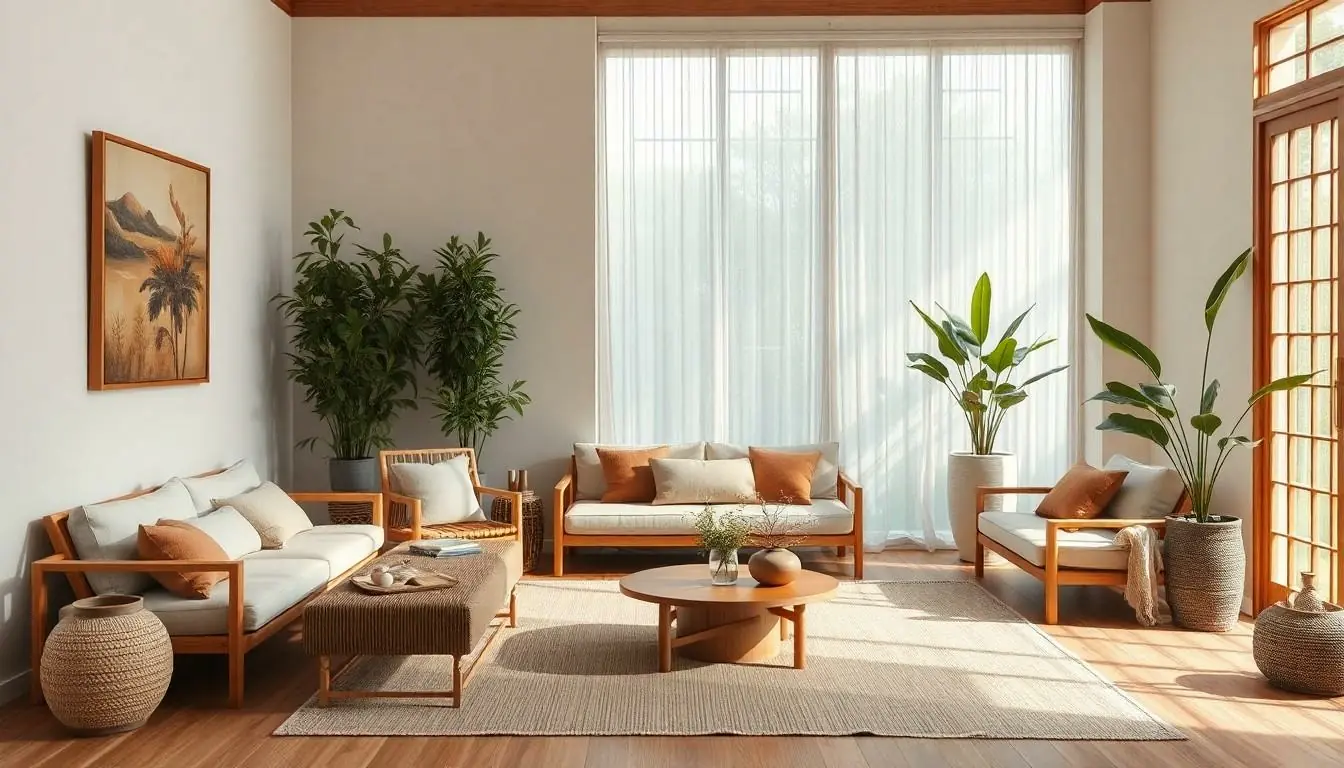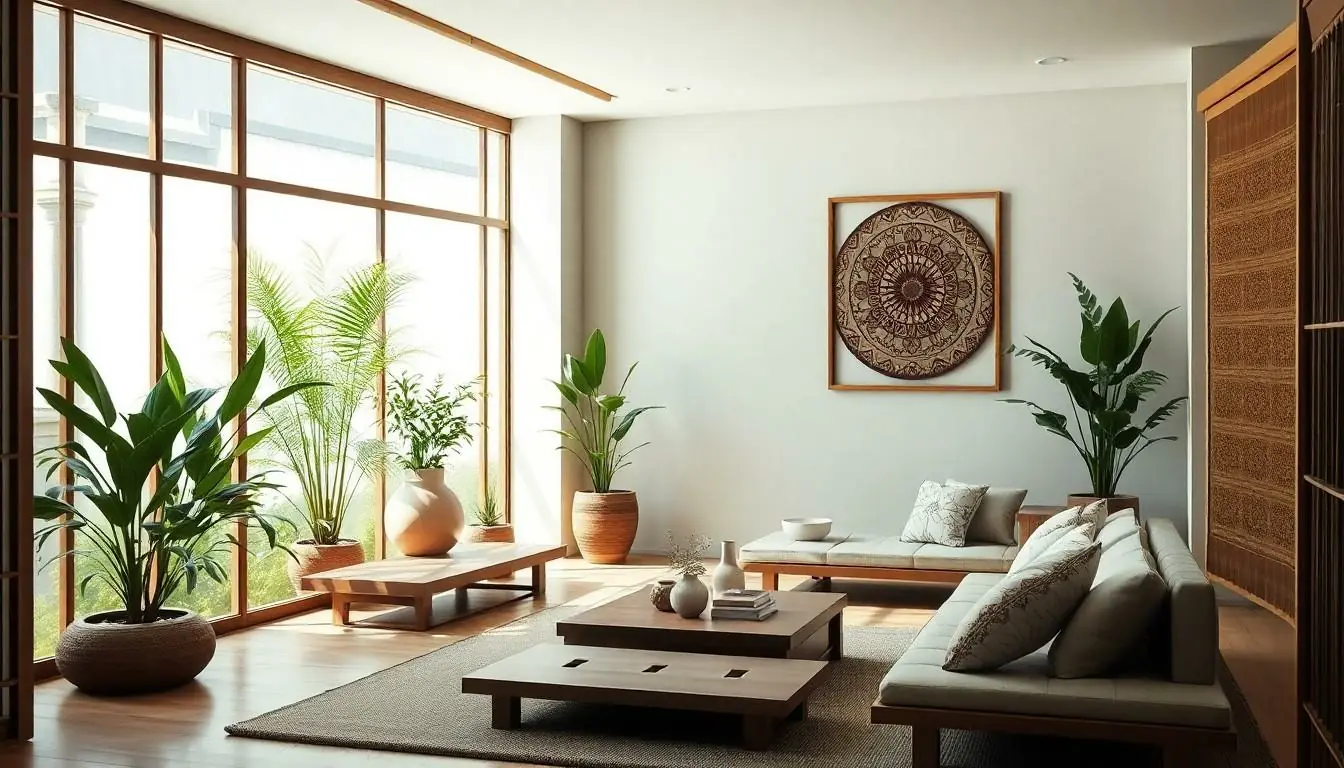Asian interior design is more than just a trend; it’s a harmonious blend of aesthetics and functionality that can transform any space into a serene oasis. Imagine walking into a room that whispers tranquility, where every element—from bamboo accents to intricate textiles—invites you to unwind. With roots steeped in centuries of tradition, this design philosophy balances nature, culture, and art in ways that make even your houseplants jealous.
Table of Contents
ToggleAsian Interior Design: An Overview
Asian interior design encompasses a blend of styles, each with unique characteristics and influences. Elements such as natural materials feature prominently, including wood, stone, and bamboo. Traditional Asian designs create a peaceful atmosphere by focusing on minimalism and simplicity.
Cultural influences from countries like Japan, China, and India shape these spaces. Japanese interiors often showcase clean lines and open spaces. Chinese design emphasizes harmony and balance, incorporating rich colors and ornate details. Indian interiors bring vibrant colors and intricate patterns that reflect the country’s rich heritage.
Color palettes in Asian design typically include earth tones and pastel shades. These colors contribute to a calming ambiance, promoting relaxation and mindfulness. Textiles play a crucial role as well, with silk, linen, and cotton fabrics used in cushions, curtains, and wall hangings.
Furniture arrangements are often versatile, prioritizing functionality and flexibility. Low seating encourages a sense of openness and connection with the floor. Accessories, like lanterns and wall art, add character while maintaining simplicity.
Incorporating plants and natural elements enhances the overall design. Indoor gardens or small water features often serve as focal points, reinforcing the connection to nature. Asian interior design reflects a respect for tradition while embracing modern interpretations harmoniously.
Ultimately, this design style transforms spaces by promoting serenity and balance, creating environments that resonate deeply with occupants.
Key Elements of Asian Interior Design

Asian interior design features distinct elements that contribute to its serene and balanced aesthetic. A focus on harmonizing natural materials and tranquil colors enhances the overall ambiance.
Color Schemes
Color schemes in Asian design typically incorporate earth tones and soft pastels. Shades like beige, green, and soft blue create calming atmospheres. Japanese interiors often utilize muted colors to promote minimalism. Chinese spaces may borrow rich reds and golds for a touch of opulence. Indian designs utilize vibrant hues that showcase cultural heritage. Each color palette facilitates relaxation and mindfulness while forming connections to nature.
Materials and Textures
Materials and textures play a crucial role in Asian interiors. Commonly used materials include wood, bamboo, and stone, which provide warmth and tranquility. Textiles like silk, cotton, and linen add richness and comfort. Bamboo accents create a natural feel and flexibility within spaces. Stone elements, such as slate or granite, enhance visual interest and durability. Layering various textures contributes depth while maintaining simplicity, striking a balance between aesthetics and functionality.
Furniture Styles
Furniture styles within Asian design prioritize simplicity and functionality. Japanese furniture often showcases low profiles and clean lines, encouraging open spaces. Chinese pieces feature intricate carvings and bold colors, emphasizing craftsmanship. Indian furniture integrates vibrant patterns and materials that reflect local traditions. Multifunctional furniture serves practical purposes while optimizing space. Arranging furniture thoughtfully fosters a sense of flow and accessibility, ensuring spaces feel inviting and harmonious.
Popular Asian Design Styles
Asian interior design encompasses a variety of styles, each with unique characteristics, reflecting the rich cultural heritage across the region. Three prominent styles include Traditional Japanese, Chinese Feng Shui, and Thai Modern.
Traditional Japanese
Traditional Japanese design emphasizes simplicity and natural beauty. Minimalism plays a key role in creating serene spaces. Shoji screens, tatami mats, and low furniture enhance the tranquil atmosphere. Natural materials, such as wood and bamboo, contribute warmth and serenity. Clutter-free environments support mindfulness and balance in daily life. Subtle color palettes incorporate earth tones, promoting calmness. Zen gardens, both indoors and outdoors, strengthen the connection to nature, fostering tranquility.
Chinese Feng Shui
Chinese Feng Shui centers around harmony and balance through spatial arrangement. This design philosophy values the energy flow within a space. Rich colors like red and gold symbolize prosperity and good fortune. Ornate details and intricate carvings characterize furniture, adding a touch of elegance. Incorporating plants and water features enhances vitality and connection with nature. Each element holds significance, aiming to create an inviting atmosphere. The careful placement of accessories ensures an optimal flow of chi, enhancing comfort and tranquility within the environment.
Thai Modern
Thai Modern design combines traditional elements with contemporary aesthetics. Vibrant colors and bold patterns reflect Thailand’s rich cultural heritage. Natural materials such as teak wood provide a warm and inviting ambiance. Innovative furniture designs prioritize functionality while maintaining artistic charm. Wall art and textiles showcase local craftsmanship, adding character to spaces. Open layouts promote interaction and flexibility, making environments feel more welcoming. Incorporating greenery throughout enhances the overall atmosphere, connecting the indoors with the surrounding nature.
Incorporating Asian Design in Modern Spaces
Asian design merges seamlessly with contemporary interiors, offering tranquility and aesthetic appeal. Elements such as natural materials and calming colors create inviting environments.
Tips for Homeowners
Homeowners can enhance modern spaces by embracing simplicity and functionality. Select furnishings crafted from wood, bamboo, or rattan to infuse warmth. Use neutral or pastel colors to promote relaxation throughout the home. Incorporate textiles like silk and cotton to add texture. Arrange furniture to encourage openness, aiming for low seating that fosters a sense of space. Incorporate decorative accessories like lanterns or minimalistic art pieces, enhancing the serene atmosphere. Consider adding living plants or small water features to strengthen the connection with nature. Prioritizing these elements reflects the essence of Asian interior design, making any home feel more inviting.
Designing for Small Spaces
Designing small spaces calls for strategic choices that maximize functionality. Prioritize multi-purpose furniture, such as storage ottomans or foldable tables, enhancing efficiency without sacrificing style. Utilize mirrors to create an illusion of spaciousness, especially in narrow areas. Incorporate light colors to brighten rooms, ensuring the space feels open. Vertical gardens or wall-mounted plants introduce greenery without taking up floor space. Use screens or dividers for creating distinct zones while maintaining flow. Every design aspect should focus on simplicity and minimalism, ensuring that small areas resonate with the calming qualities of Asian design.
Asian interior design offers a unique approach that harmonizes aesthetics with functionality. Its emphasis on natural materials and calming color palettes creates inviting spaces that promote relaxation and mindfulness. By integrating elements from various cultures, homeowners can transform their environments into serene retreats that reflect personal style and heritage.
Incorporating Asian design principles not only enhances the beauty of a space but also fosters a deeper connection to nature. Whether through minimalist Japanese layouts or vibrant Indian patterns, each style brings its own charm. Ultimately, embracing Asian interior design can lead to a more balanced and peaceful living experience.




